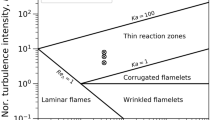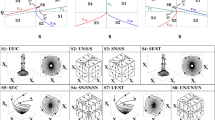Abstract
2D Direct Numerical Simulations of methane/air turbulent premixed flames at initial Karlovitz numbers ranging from 600 to 9500 are performed. Instantaneous results are then extracted and analyzed with a focus on the inner flame structure. Snapshots reveal that the distributed reaction zone regime, theoretically reached around Ka ≈ 100, is not attained before Ka ≈ 2000. A correction of the definition of Ka is proposed in order to account for gas expansion across the flame, and is found to be consistent with the previous observations. The fuel-consumption zone is shown to be highly affected by turbulence and the characteristics of flames developing at lower Ka cannot be seen: the reaction zone is indeed strongly stretched and curved by intense turbulence leading to the formation of large protruding structures. In addition, the heat release rate layer is found to be broader and more distributed than at lower Ka as small turbulent eddies are able to survive inside it. No local flame quenching is however noticed. A statistical analysis of the distributed flame highlighted three major features characterizing this regime: significant broadening of the whole flame results from the presence of small eddies inside the reaction zone, temperature evolves linearly with respect to the progress variable and minor species peak mass fractions are lower than in a laminar flame. These results have important consequences for turbulent combustion modelling of flames in the distributed combustion regime.
Similar content being viewed by others
References
Borghi, R.: Mise au point sur la structure des flammes turbulentes. J. Chim. Phys. 81, 361–370 (1984)
Peters, N.: Turbulent Combustion. Cambridge University Press (2000)
Mansour, M.S., Peters, N., Chen, Y.C.: Investigation of scalar mixing in the thin reaction zones regime using a simultaneous CH LIF/Rayleigh laser technique. Proc. Comb. Inst. 27, 767–773 (1998)
Li, Z.S., Kiefer, J., Zetterberg, J., Linvin, M., Leipertz, A., Bai, X.S., Alden, M.: Development of improved PLIF CH detection using an Alexandrite laser for single-shot investigation of turbulent and lean flames. Proc. Comb. Inst. 31, 727–735 (2007)
Kiefer, J., Li, Z.S., Zetterberg, J., Bai, X.S., Alden, M.: Investigation of local flame structures and statistics in partially premixed turbulent jet flames using simultaneous single-shot CH and OH planar laser-induced fluorescence imaging. Combust. Flame 154, 802–818 (2008)
Li, Z.S., Li, B., Sun, Z.W., Bai, X.S., Alden, M.: Turbulence and combustion interaction: High resolution local flame front structure visualization using simultaneous single-shot PLIF imaging of CH, OH and CH2O in a piloted premixed jet flame. Combust. Flame 157, 1087–1096 (2010)
Dunn, M.J., Masri, A.R., Bilger, R.W.: A new piloted premixed jet burner to study strong finite-rate chemistry effects. Combust. Flame 151:46–60 (2007)
Sjoholm, J., Rosell, J., Li B., Richter, M., Li, Z.S., Bai, X.S., Alden, M.: Simultaneous measurements of OH, CH, CH2O and Toluene LIF in a methane jet flame with varying degrees of turbulence. Proc. Comb. Inst. 34 (2012). doi:10.1016/j.proci.2012.05.037
Poinsot, T.J., Veynante, D., Candel, S.: Quenching processes and premixed turbulent combustion diagrams. J. Fluid Mech. 228, 561–606 (1991)
Poludnenko, A.Y., Oran, E.S.: The interaction of high-speed turbulence with flames: global properties and internal flame structure. Combust. Flame 157, 995–1011 (2011)
Aspden, A.J., Day, M.S., Bell, J.B.: Lewis number effects in distributed flames. Proc. Comb. Inst. 33, 1473–1480 (2011)
Aspden, A.J., Day, M.S., Bell, J.B.: Characterization of low Lewis number flames. Proc. Comb. Inst.33, 1463–1471 (2011)
Aspden, A.J., Day, M.S., Bell, J.B.: Turbulence flame interactions in lean premixed hydrogen: transition to the distributed burning regime. J. Fluid Mech. 680, 287–320 (2011)
Pencil Code, a high-order finite-difference code for compressible hydrodynamic flows with magnetic fields and particles. http://code.google.com/p/pencil-code/ (2011). Accessed 10 Oct 2011
Babkovskaia, N., Haugen, N.E.L., Brandenburg, A.: A high-order public domain code for direct numerical simulations of turbulent combustion. J. Comp. Physiol. 230, 1–12 (2011)
Smooke, M.D., Giovangigli, V.: Formulation of the premixed and nonpremixed test problems. In: Reduced Kinetic Mechanisms and Asymptotic Approximation for Methane-air Flames. Springer Verlag, Berlin (1991)
Mourits, M.M, Rummens, F.H.A.: A critical evaluation of Lennard-Jones and Stockmayer potential parameters and some correlation methods. Can. J. Chem. 35, 3007–3020 (1977)
Wilke, C.R.: A viscosity equation for gas mixtures. J. Chem. Phys. 18, 517–519 (1950)
Poinsot, T., Candel, S., Trouv, A.: Applications of direct numerical simulation to premixed turbulent combustion. Prog. Ener. & Comb. Sci. 21, 531–576 (1996)
Liu, C., Yan, B., Chen, G., Bai, X.S.: Structures and burning velocity of biomass derived gas flames. Int. J. Hydrogen Energy 35, 542–555 (2010)
Seshadri, K., Peters, N.: The inner structure of methane-air flames. Combust. Flame 81, 96–118 (1990)
Echekki, T., Chen, J.H.: Unsteady strain rate and curvature effects in turbulent premixed methane-air flames. Combust. Flame 106, 184–190 (1996)
Driscoll, J.F.: Turbulent premixed combustion: flamelet structure and its effect on turbulent burning velocities. Prog. Ener. & Comb. Sci. 34, 91–134 (2008)
Mueller, C.J., Driscoll, J.F., Reuss, D., Drake, M.C.: Vorticity generation and attenuation as vortices convect through premixed flames. Combust. Flame 112, 342–358 (1998)
Vervisch, L., Hauguel, R., Domingo, P., Rullaud, M.: Three facets of turbulent combustion modelling: DNS of premixed V-flame, LES of lifted non-premixed flame and RANS of jet-flame. J. Turbul. 5, 1–36 (2004)
Lipatnikov, A.N., Chomiak, J.: Turbulent fame speed and thickness: phenomenology, evaluation, and application in multi-dimensional simulations. Prog. Ener. & Comb. Sci. 28, 1–74 (2002)
Author information
Authors and Affiliations
Corresponding author
Rights and permissions
About this article
Cite this article
Savre, J., Carlsson, H. & Bai, X.S. Tubulent Methane/Air Premixed Flame Structure at High Karlovitz Numbers. Flow Turbulence Combust 90, 325–341 (2013). https://doi.org/10.1007/s10494-012-9426-8
Received:
Accepted:
Published:
Issue Date:
DOI: https://doi.org/10.1007/s10494-012-9426-8




